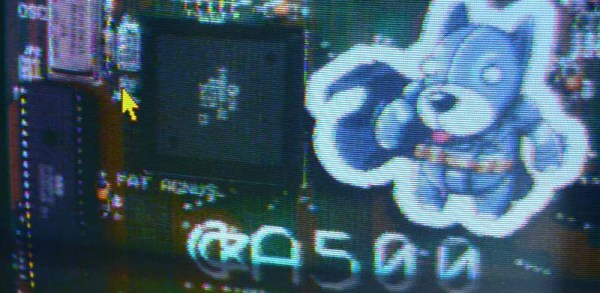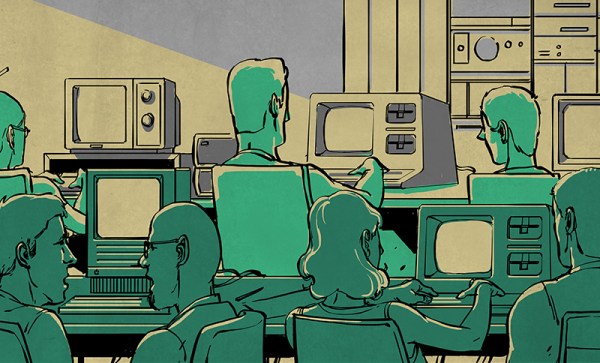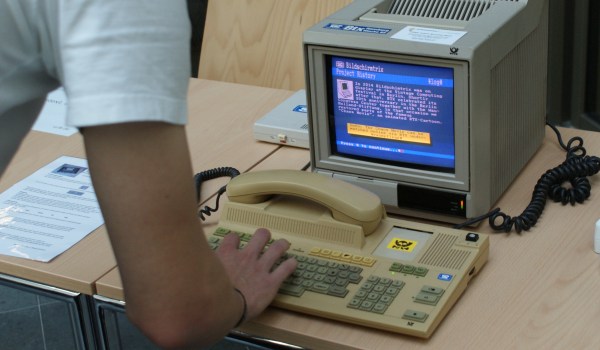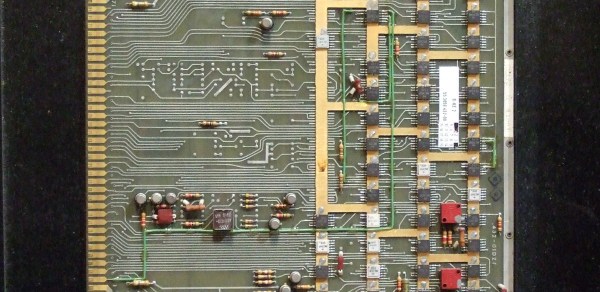There was a time in the late 80s and early 90s where the Amiga was the standard for computer graphics. Remember SeaQuest? That was an Amiga. The intro to Better Call Saul? That’s purposefully crappy, to look like it came out of an Amiga. When it comes to the Amiga and video, the first thing that comes to mind is the Video Toaster, hardware and software that turns an Amiga 2000 into a nonlinear video editing suite. Digital graphics, images, and video on the Amiga was so much more than the Video Toaster, and at this year’s Vintage Computer Festival East, [Bill] and [Anthony] demonstrated what else the Amiga could do.
Vintage Computer Festival29 Articles
Hackaday Teams With Vintage Computer Festival For Retro Hackathon
For the last few years, we’ve been going to the Vintage Computer Festival East in New Jersey. This is one of the best cons we go to every year; there are dozens of interesting exhibitors, awesome talks, a great venue, and a small consignment area filled with the weirdest stuff you can imagine. This year proves to be no different, and we’ll be there cataloging the weirdness and spectacular hacks of computer systems old enough to vote, plus something new.
Hackaday’s 8-bit game programming contest is happening for the first time at VCF East, April 15-17 in Wall, New Jersey. Competitors are given two and a half hours and an old 8-bit system (Apple II, C64, Atari 800, etc.). The goal is to create a game using only what is currently in memory, be that in the ROM or between the ears. There are two sessions on the Friday of the event, starting at 10am and 2:30pm.
You can call the 8-bit game programming contest a hackathon. That’s basically what it is; getting a small team together to whip up an application quickly with a number of constraints. The term ‘hackathon’ has been bastardized as of late, with companies requiring the use of a particular API or other nonsense. The 8-bit programming contest doesn’t have these limitations. All you need to do is create the coolest game in two and a half hours, and get the most applause from the audience. The best game wins a prize.
Of course, we’re not going to VCF East just to promote a retro hackathon. We’re only obliged to mention that first because we’re sponsoring it. VCF East is a fantastic event, with more retro goodies to satiate even the most curmudgeonly retro aficionado. The show is enormous with keynotes from [John Blankenbaker], inventor of the Kenbak-1 personal computer and [Stewart Cheifet], host of Computer Chronicles. Dr. Dr. Ted Nelson, author of Computer Lib and creator of Xanadu, the underlying software for computers that won’t be built for 100 years, will also be there. The weekend is, as always, packed with great exhibits of ancient tech, classes, and workshops.
Each Vintage Computer Festival is different, but if you’d like a sample of what it’s all about, check out these posts:
- Flappy Bird for the TI-99 and Fahrfall for the CoCo
- Virtual Reality on a Commodore PET
- Minicomputing with a Raspberry Pi
- The world’s largest USB thumb drive
- Amigas and Macs that weren’t built by Apple
- The 2015 VCF East Mega Mix
- The 2014 VCF East Mega Mix
Apart from an announcement for the festival in New Jersey, there are a lot of changes in the organization of the various vintage computer festivals held around the country. The Vintage Computer Festival East was formerly organized by MARCH, the Mid-Atlantic Retro Computing Hobbyists. Late last year, MARCH was dissolved, and reformed as a 501(c)3 called the Vintage Computer Federation. The VCF (see what they did there?) also has the rights to hold VCF West, which last happened in 2007. The VCF Midwest, Southwest, Europe, and UK will remain independent.
If it isn’t already extremely obvious, this is one of the top-tier events we go to every year. No, it’s not DEF CON, it’s not HOPE, and it’s certainly not a big con. It’s just a bunch of nerds nerding out, which is the critical ingredient for the best events we attend all year.
Vintage Computer Fest: Berlin 2015
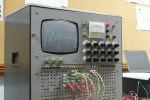 Berlin was a good city to be a geek in last weekend. Alongside the Berlin Maker Faire, there was the 2015 meeting of the Vintage Computing Festival: Berlin (VCFB). Each VCFB has a special theme, and this year it was analogue computers, but there was no lack of old computers large and small, teletext machines, vintage video game consoles, and general nerdy nostalgia.
Berlin was a good city to be a geek in last weekend. Alongside the Berlin Maker Faire, there was the 2015 meeting of the Vintage Computing Festival: Berlin (VCFB). Each VCFB has a special theme, and this year it was analogue computers, but there was no lack of old computers large and small, teletext machines, vintage video game consoles, and general nerdy nostalgia.
Vintage Computer Festival Europa 16.0: The Hackaday Report
The 16th annual Vintage Computer Festival Europa (VCFe) is still ongoing this weekend in Munich, and of course Hackaday had to swing by. If you’re anywhere in Germany, you’ve still got until Sunday at 16:30 to check it out.
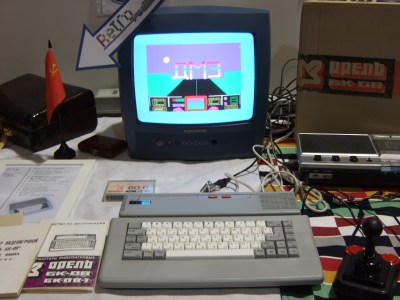 The theme for this year’s festival is “The East is
The theme for this year’s festival is “The East is Red Colorful” and that means vintage computers from the other side of the Iron Curtain. Here in (West) Germany, that naturally means a good representation of computers from the former Democratic Republic of Germany (DDR), but Czechoslovakia, Yugoslavia, and of course Russia were also in the house. There was far too much going on to cover it all, but here’s a few of the projects and computers that caught our eye.
Continue reading “Vintage Computer Festival Europa 16.0: The Hackaday Report”
Hackaday Links: January 18, 2015
A little while ago, we complained that there aren’t many projects using the Microview, a very cool Arduino and OLED thing that might be just too big for a ring. [Johannes] answered the call with a slot car track timer. He’s using an infrared distance sensor to count off lap times for his slot car track and a mini thermal printer to print out the times. Video right here.
Too many cables in your freshman college dorm room? Here’s the solution.
Our Internet travels frequently take us to strange auctions (we’re still looking for a US Mail truck, btw), but this one takes the cake. 24kt gold plates that were flown in space for five and a half years weighing 6,015.5 grams (212.191 oz). At the current price of $1277.06/oz, this auction should go for $270,980 USD. I’m 99% sure this was part of the Long Duration Exposure Facility, but I have no clue why this much gold was flown. Surely they could have done the same amount of science with only a hundred thousand dollars worth of gold, right?
So here’s this, but this isn’t your everyday, “put an Arduino in a vibrator” crowdfunding campaign. No, they actually have some great tutorials. Did you know that a stroke sensor looks like shag carpeting? [Scott] tells us, “I believe the founders are all graduate students getting PhDs in something or other, starting a sex toy company on the side.” More power to ’em.
Speaking of dildonics, the guy who coined that term will be giving one of the keynotes at the Vintage Computer Festival East this year. Yes, we’ll be there in full force.
MARCH Attends HOPE X In July

The Mid-Atlantic Retro Computing Hobbyist (MARCH) group is at HOPE X displaying a chronology of Apple computers, everything from an accurate Apple 1 reproduction all the way way up to an Apple Macintosh, and of course including all the II’s in between. Although they are only displaying Apples at this event, don’t confuse them for an Apple group. They love all types of vintage computers from the 1940’s to the 80’s.
[Evan], president of the group, elegantly explained why they are here; “to let people know that vintage computing is a thing and there are people in the area that do that thing”. He would like to encourage everyone who is mildly interested in retro computing to contact their local retro computer group and get involved in the community.
The group also puts on a yearly Vintage Computer Festival in New Jersey. This year’s event has already passed but you can still see what happened as Hackaday was there documenting all the cool stuff.

This Weekend: Hackaday At The Southeast Vintage Computer Festival

The Vintage Computer Festival hits Roswell, GA this weekend for the second year, packed with museum displays dating back to the Kenbak 1 and hobbyist vintage exhibits. The Apple Pop-Up museum is back as well, along with last year’s popular retro gaming area and a maker-styled kit building area. Here’s an album packed with images from last year’s festival, so you know what you’re getting yourself into.
You can check out the scheduled speakers and workshops here. While you’re there, look for the short, nerdy guy wearing a Hackaday shirt and I’ll be sure to throw some Hackaday stickers at you.

